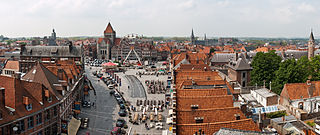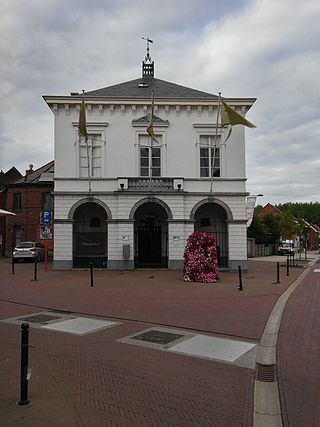Brabant is a traditional geographical region in the Low Countries of Europe. It may refer to:

Ghent is a city and a municipality in the Flemish Region of Belgium. It is the capital and largest city of the East Flanders province, and the third largest in the country, after Brussels and Antwerp. It is a port and university city.

Oostkamp is a municipality located in the Belgian province of West Flanders. The municipality comprises the villages of Hertsberge, Oostkamp proper, Ruddervoorde and Waardamme. On January 1, 2019, Oostkamp had a total population of 23,698. The total area is 79.65 km² which gives a population density of 289 inhabitants per km².

Roeselare is a Belgian city and municipality in the Flemish province of West Flanders. The municipality comprises the city of Roeselare proper and the towns of Beveren, Oekene and Rumbeke.

Mechelen is a city and municipality in the province of Antwerp in the Flemish Region of Belgium. The municipality comprises the city of Mechelen proper, some quarters at its outskirts, the hamlets of Nekkerspoel (adjacent) and Battel, as well as the villages of Walem, Heffen, Leest, Hombeek, and Muizen. The river Dyle (Dijle) flows through the city, hence it is often referred to as the Dijlestad.

Puurs is a former municipality located in the Belgian province of Antwerp. It is located in the Flemish Region. The municipality comprised the towns of Breendonk, Liezele, Kalfort, Ruisbroek and Puurs proper. There is also the hamlet of Kalfort. In 2021, Puurs had a total population of 17,684. The total area is 33.41 km2 (13 sq mi).

Sint-Amands is a town and a former municipality located in the Belgian province of Antwerp, Belgium. The municipality comprises the towns of Lippelo, Oppuurs and Sint-Amands proper. In 2021, Sint-Amands had a total population of 8,524. The total area is 15.58 km2. Sint-Amands is located at the right bank of the Scheldt river.

Sint-Pieters-Leeuw is a municipality in the province of Flemish Brabant, in the Flemish region of Belgium.

Wemmel is a municipality located in the Belgian province of Flemish Brabant. The municipality only comprises the town of Wemmel proper. On January 1, 2018, Wemmel had a total population of 16,347. The total area is 8.74 km² which gives a population density of 1,870 inhabitants per km².
Articles related to Belgium include:

Tournai or Tournay is a city and municipality of Wallonia located in the Province of Hainaut, Belgium. It lies 89 km (55 mi) by road southwest of the centre of Brussels on the river Scheldt, and is part of Eurometropolis Lille–Kortrijk–Tournai, In 2022, the municipality of Tournai had an estimated population of 68,518 people.

Breendonk is a village in the municipality of Puurs-Sint-Amands in the province of Antwerp, Belgium, with a population of 3,000, halfway between Brussels and Antwerp.

The House of Merode is one of the most prominent families of the Belgian nobility. It originates from the village of Merode, which is now in the municipality of Langerwehe in Germany. Over the past five centuries, different branches bore noble titles and had estates on the territories of the modern-day states of Germany, Belgium, the Netherlands, France and Austria. Through marriage, the house is connected with many prominent European noble families. The House of Merode played an important role in the history of the Southern Netherlands and the Kingdom of Belgium.

Lippelo is a village in the Belgian province of Antwerp. It is a part of the municipality of Puurs-Sint-Amands. Lippelo has a population of 1,138 as of 2021.

Liezele is a village and deelgemeente (sub-municipality) of the municipality of Puurs-Sint-Amands in the province of Antwerp, Belgium. The village is located about 20 kilometres (12 mi) south-south-west of the city of Antwerp. On the night of 4 to 5 September 1914, the entire village was destroyed by the Belgian Army to deny the Germany Army cover.

Vilain and Vilain XIIII is a Belgian noble family. Their coat of arms is basically "Sable, on a chief argent a label of the field", a colour scheme that is present from the earliest Vilains in the 15th century, and is also seen in the Vilain XIIII arms, which have the "XIIII" added to it.
Ruisbroek may refer to multiple places in Belgium:

The Snoy family or Snoy d'Oppuers currently Snoy et d'Oppuers, is a Belgian noble family. The current descendants are titled Barons Snoy and of Oppuers.

Puurs-Sint-Amands is a municipality in the Belgian province of Antwerp that arose on 1 January 2019 from the merging of the municipalities of Puurs and Sint-Amands.

Ruisbroek is a village in the municipality of Puurs-Sint-Amands located in the Antwerp Province of Belgium.






















